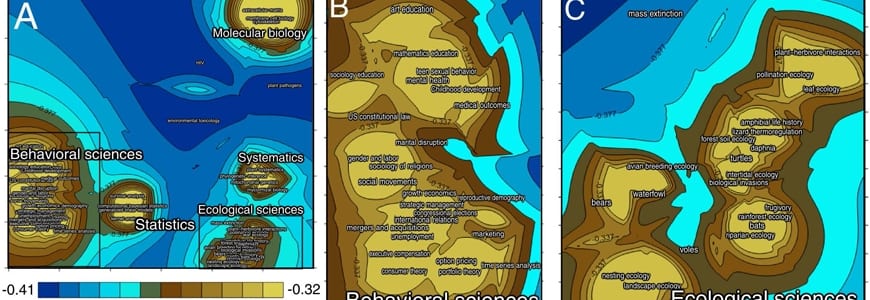By Rob Mitchum // September 8, 2014
England and the United States have been described as “two countries separated by a common language.” The same observation could be made about science, though in the case of scientific disciplines, the number of countries ranges into the hundreds or thousands. Though English is the primary language used for the communication of scientific and scholarly research, fields have developed highly specific jargon that, in some cases, isolates their work from use by other fields or the general public. But in a new paper in Sociological Science, co-authored by researchers from the CI’s Knowledge Lab and the Metaknowledge Research Network, those linguistic differences offer the cartographical key to mapping the topography of science.
Though often treated as the bogeyman of scientific communication, jargon develops for a reason, the paper’s authors write, quoting 18th century French philosopher Etienne Bonnot de Condillac, “Every science requires a special language, because every science has its own ideas.” In many cases, jargon offers a useful shorthand for those ideas to be communicated between peers within a field quickly and precisely.
However, multidisciplinary research grows ever more common and — for certain critical matters such as climate change or medical technology — more important. “Cultural holes,” a term coined in 2010 to describe the lack of a common culture between two entities, make it harder for collaborations to form or thrive between fields, slowing the pace of discovery. To identify these cultural holes in science, a team led by Daril Vilhena of the University of Washington and including CI Senior Fellow and Knowledge Lab director James Evans and Metaknowledge Research Network members Jacob Foster and Carl Bergstrom used old and new methods to survey the scholarly landscape.
Previously, researchers used citations to construct a structural network of science. When a paper in one field cites a paper from another — say, a biology paper references a sociology publication — that reflects a link between those two fields. The frequency of such links determines the strength of the network connection between any two fields, and the resulting network traces the skeleton of science.
For their analysis, Vilhena and colleagues created this kind of citation network for 60 fields based on the digital library JSTOR, which contains over 2,000 scholarly journals. But they then constructed a second network, using the text of more than 1.5 million articles to look at the efficiency of communication between different fields. When two fields share many of the same words and phrases, the cost of communication between the two is low. But when two fields each use many different pieces of jargon that never or rarely appear in the other, the communication cost is high, reflecting a “cultural hole.” By measuring these costs for all the combinations of the 60 fields represented in the study, the authors created a topography of the scientific landscape, with peaks and valleys representing ease or difficulty of communication.
The two methods combined to create a new map of science, one that resembles a loose confederation of islands. A large landmass covers the social/behavioral sciences, while scattered islands represent different subsets of biological science — ecology, molecular biology, systematics. Between these two regions sits the island of statistics, reflecting its shared usage by both biology and social science.
The terrain gives the viewer a quick guide to the location of the chasms of science, carved out by the deepest differences in terminology. “Wading into another literature with substantial jargon will literally take the reader under water,” the authors write. Meanwhile, the continuous mass of social sciences reflects more fluidity of language between those fields, while the biological sciences are “balkanized” by jargon, with ecology and molecular biology separated at great distance according to citations and culture.
Even within these sub-fields, the map shows different geographies. Ecology is an “archipelago” of different areas of study, sometimes organized around a particular type of animal, surrounded by “moats of jargon.” Conversely, cellular and molecular biology, despite being isolated from other fields within biology, share a great deal of terminology and, thus, communicate efficiently with their neighbors.
Like the world explorers of old, the authors hope their new map will inspire new investigations into the science of science. Interactions between the citation network and the language network, how new fields find their place in the scientific landscape, and what happens when two fields merge are just some of the questions that could be pursued — and already are, by members of the Knowledge Lab and Metaknowledge Research Network. The answers could help further map the complex world of science and scholarship…and open up new territories for fruitful discovery.

